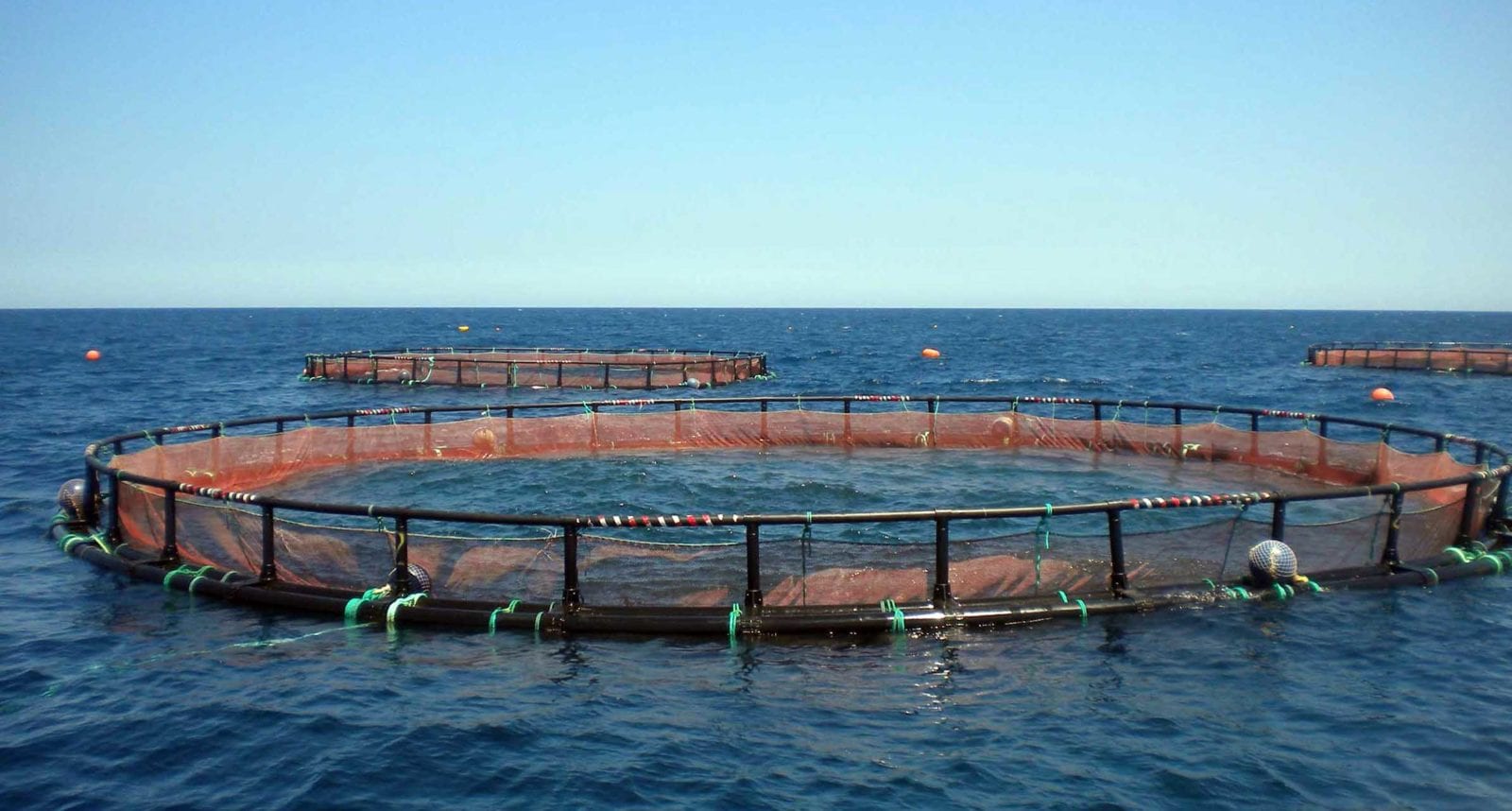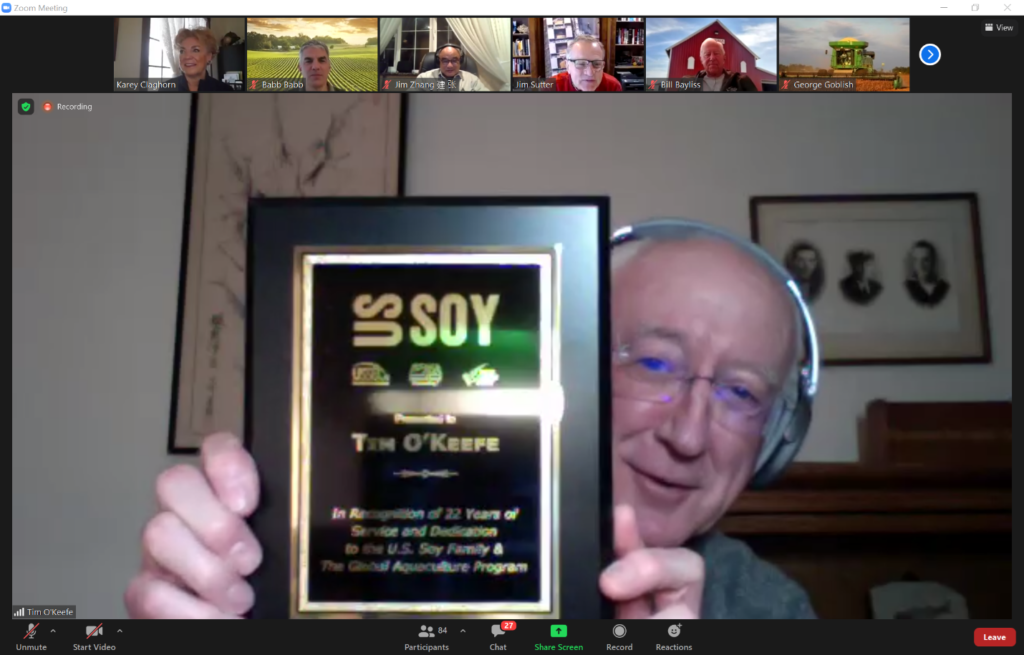Celebrating a Leader in Aquaculture
- Category:
- General News

Many may know about aquaculture as it stands today: An industry rapidly growing at 7-10% globally to meet seafood consumption needs and feed an expanding population. However, there is a great deal to reflect on with how far the industry has come, and how it will continue to develop in the future.
Through the years, the U.S. Soybean Export Council (USSEC) has had the honor of working with an aquaculture pioneer: Tim O’Keefe of Aqua-Feed Technologies, Inc. (AFT). O’Keefe is an aquafeed specialist with experience in fish and shrimp nutrition, diet formulation, and food manufacturing. After 45 years in the field, he is retiring.
O’Keefe first started working with fish as a graduate student in 1973 while attending Texas A&M University. After receiving an undergraduate degree in biochemistry, he continued his education there on a full-ride scholarship to study fish nutrition.
Today, USSEC recognized his for his 22+ years of service to the U.S. Soy industry during its Global Aquaculture Briefing with representatives from qualified state soybean boards, and leaders from the American Soybean Association and United Soybean Board.
“Tim’s 45 years of experience in fish and shrimp nutrition diet formulation and feed manufacturing is second to none, and we have valued our relationship with him which has spanned more than two decades of work,” said Jim Sutter, USSEC CEO during a short presentation. “The partnership between USSEC and Aqua Feed Technologies has really allowed for the breakthrough and adoption of Soy-Optimized Floating Feeds.”
O’Keefe explained that it was by luck that he got a job after finishing my graduate degree with Union Carbide Corporation.
“Their corporate research division hired me because they acquired a salmon farm in the Pacific Northwest, and at the time, those in the field were feeding frozen fresh diets to salmon, and it was a huge problem,” he said. “Union Carbide’s mission was to develop dry diets.”
Here O’Keefe learned the latest and greatest when it comes to aqua nutrition, and he became well-trained in laboratory methods, statistical inference and other sought-after research and development skills.
“Aquaculture has come a very long way,” O’Keefe said. “Back in the early days when I worked for trout farms, we were lucky to keep fish alive past swim-up stage.
“Early trout farmers used liver and spleen from wild mustangs and disabled cattle for fish feed. It was a rough business that needed to settle down and focus on developing commercial feeds in much the same way as the poultry industry did.”
While doing some work in Idaho, O’Keefe met Bob Smith, who worked for U.S. Fish and Wildlife Service’s Tunison Laboratory of Fish Nutrition. It was then that he was introduced to the concept of using roasted, full-fat soybeans to feed trout.
“I learned a lot from Bob,” O’Keefe said. “With his guidance, we produced high-performance trout diets containing up to 50% full-fat soy, and farmers couldn’t believe how well it worked!”
Soybeans are a great source of protein and essential amino acids, omega-3 fatty acids, and phospholipids, O’Keefe said, adding that the high quality, reliable supply, and competitive pricing of U.S. soy makes it particularly attractive.
In 1998, O’Keefe attended a World Aquaculture Conference in Las Vegas that changed the trajectory of his consulting business. He met Mike Cremer, who at the time served as aquaculture director for the American Soybean Association. He asked O’Keefe to provide technical nutrition assistance to ASA’s aquaculture marketing program in China. From this first meeting more than two decades ago until now, USSEC has relied on O’Keefe’s leadership and expertise.
“USSEC has had a huge role in the global growth of aquaculture,” O’Keefe said. “Their vision and leadership brought people together in a worldwide aquaculture program with a clear focus on what needed to be done to sustainably produce more fish and shrimp.
“They introduced production technologies like 80:20 pond culture, low volume-high density (LVHD) cage culture, and most recently in-pond raceway system (IPRS) technology.”
O’Keefe explained that development and implementation of these culture technologies, made possible by funding from the soybean farmers of the United States, significantly contributed to the successes that we see in aquaculture today.”
There is a lot to look forward to in the future of aquaculture. By 2050, experts estimate the global population will reach 10 billion, and the world will need to produce 70% more of every food than we currently do. To meet this demand, aquaculture production will need to increase by 46 million metric tons by 2030.
How does aquaculture continue to innovate, and what are the next steps the industry needs to take?
“Aquaculture development efforts now focus on genetics,” O’Keefe said. “This is one area that has lagged behind nutrition, culture techniques, and disease prevention and control.
“I’ve heard it said that if the poultry farmers were still growing chickens with the genetics available in the 1950s and 60s, we would starve to death. That level of genetic improvement needs to happen in the aquaculture business. It is getting better and better, particularly with automation of gene sequencing. We already see significant improvements in growth rate, disease resistance, and body conformation in genetically improved strains of both fish and shrimp.”
The role of nutrition in aquaculture is not just to feed the animal and the world, but to do it sustainably. To stay ahead of the curve, U.S. soybean farmers have developed a comprehensive program called Soybean Sustainability Assurance Protocol (SSAP). Learn more by visiting our website here.
In the next 10 years, O’Keefe predicts we will see new areas of the world become big production centers for aquaculture.
“Certain areas of the world, particularly Sub-Saharan Africa, are going to grow exponentially,” O’Keefe said. “Food production in this region of the world has struggled for a long time, but the food habits of people there accept fish readily, and they have the critical aquatic natural resources needed to support growth. It is a vastly untapped area.”
As of this point in time, O’Keefe explained most of the technical marketing efforts to promote the use of U.S. soybeans in aquafeeds have targeted aquaculture in the northern hemisphere. This is where most of the global aquaculture production is currently located. However, fish are cold-blooded animals. Their maximum food and, therefore, soybean meal consumption in northern latitudes is from May through October -- the exact time when U.S. beans are being planted, grown, and harvested.
He said turning to the Southern Hemisphere for market development will promote soy demand in aquafeed during the time when U.S. beans and meal are most available.
“We shouldn’t abandon marketing efforts in the north, but promoting further development of aquaculture in Sub-Saharan Africa, the Asian Subcontinent, and Australia will create greater demand for soy when South American beans are less available,” O’Keefe noted.
Even in retirement, O’Keefe continues to work in the field of fish nutrition by educating future aquaculturists. He serves as a guest lecturer at the College of Southern Idaho, where he volunteers his time to help teach students in the aquaculture technology program.
“As the saying goes, ‘I’ve been warmed by fires I didn’t build, and I’ve gotten water from wells I didn’t dig,’” O’Keefe said. “Now’s a great time to give back.”
